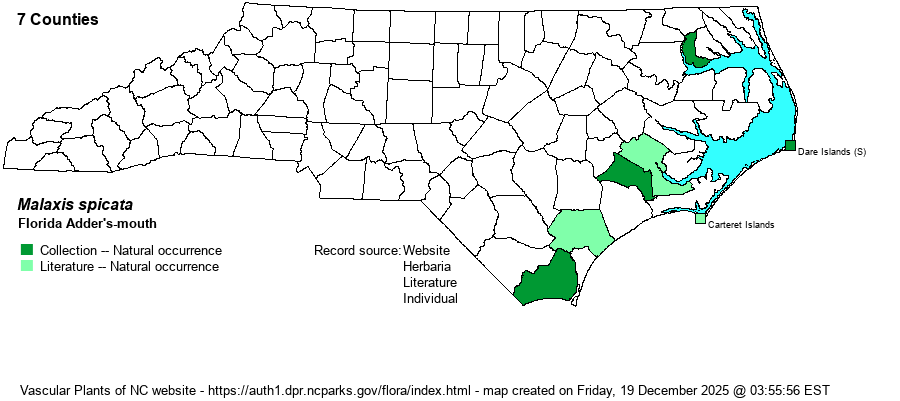| Author | Swartz | |
| Distribution | Restricted to the lower Coastal Plain, and mainly from the Croatan National Forest (Craven/Jones/Carteret counties) south to the SC line. It is found within the Buxton Woods area near Cape Hatteras, and on Bogue Banks in Carteret County, but otherwise occurs on the mainland.
This is a Southern species, mainly limited to the lower Atlantic Coastal Plain from southeastern VA to GA, and then throughout FL. Also in the Bahamas and West Indies. | |
| Abundance | Rare from the SC line north to Craven County, and very rare farther northward near the coast. This is a State Special Concern species. | |
| Habitat | This orchid has quite specific habitat requirements. It requires damp soil, but also one that has a high pH. It is found in maritime swamps and wet spots within maritime forests, but also in damp forested areas over marl, such as along creeks or pool margins in hardwood stands. | |
| Phenology | Blooms from July to October, and fruits shortly after flowering. | |
| Identification | Though very few biologists have seen this species in NC, it is rather distinctive, though a rather small plant. It is deciduous, with a stem reaching only about 6-8 inches tall, with typically two broadly elliptic, nearly opposite, and shiny leaves clasping the lower part of the stem. The leaves are roughly 2-3 inches long and about half as wide. The top portion of the stem contains the roughly 10-20 very small flowers, each smaller than 1/4-inch across, greenish with a brown tint, but most notably with a striking reddish-orange lip. You may need to bend down to see the red-orange lip, however. Sadly, there are no large populations known in NC, and more than likely you will probably see no more than just a handful of plants at any site. | |
| Taxonomic Comments | None
| |
| Other Common Name(s) | None | |
| State Rank | S1 | |
| Global Rank | G4? | |
| State Status | SC-V | |
| US Status | | |
| USACE-agcp | OBL link |
| USACE-emp | | |

